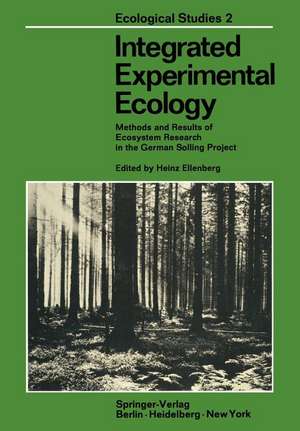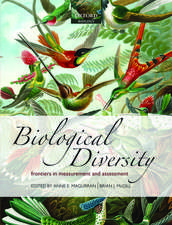Integrated Experimental Ecology: Methods and Results of Ecosystem Research in the German Solling Project: Ecological Studies, cartea 2
Editat de H. Ellenbergen Limba Engleză Paperback – 25 ian 2012
Din seria Ecological Studies
- 18%
 Preț: 1118.93 lei
Preț: 1118.93 lei -
 Preț: 553.72 lei
Preț: 553.72 lei - 18%
 Preț: 1680.55 lei
Preț: 1680.55 lei - 18%
 Preț: 1003.38 lei
Preț: 1003.38 lei - 20%
 Preț: 1004.71 lei
Preț: 1004.71 lei -
 Preț: 480.62 lei
Preț: 480.62 lei - 5%
 Preț: 752.26 lei
Preț: 752.26 lei - 15%
 Preț: 643.99 lei
Preț: 643.99 lei - 15%
 Preț: 644.18 lei
Preț: 644.18 lei - 15%
 Preț: 652.49 lei
Preț: 652.49 lei - 18%
 Preț: 789.83 lei
Preț: 789.83 lei -
 Preț: 382.36 lei
Preț: 382.36 lei - 15%
 Preț: 643.48 lei
Preț: 643.48 lei - 15%
 Preț: 646.30 lei
Preț: 646.30 lei - 15%
 Preț: 634.32 lei
Preț: 634.32 lei -
 Preț: 384.86 lei
Preț: 384.86 lei - 18%
 Preț: 789.98 lei
Preț: 789.98 lei - 15%
 Preț: 645.14 lei
Preț: 645.14 lei - 15%
 Preț: 649.39 lei
Preț: 649.39 lei - 18%
 Preț: 1005.43 lei
Preț: 1005.43 lei - 18%
 Preț: 949.23 lei
Preț: 949.23 lei - 15%
 Preț: 649.54 lei
Preț: 649.54 lei - 15%
 Preț: 643.34 lei
Preț: 643.34 lei - 15%
 Preț: 649.71 lei
Preț: 649.71 lei - 15%
 Preț: 638.76 lei
Preț: 638.76 lei - 18%
 Preț: 957.62 lei
Preț: 957.62 lei - 18%
 Preț: 1235.25 lei
Preț: 1235.25 lei - 18%
 Preț: 962.18 lei
Preț: 962.18 lei - 18%
 Preț: 949.23 lei
Preț: 949.23 lei - 15%
 Preț: 660.68 lei
Preț: 660.68 lei -
 Preț: 397.76 lei
Preț: 397.76 lei - 15%
 Preț: 638.24 lei
Preț: 638.24 lei - 18%
 Preț: 942.31 lei
Preț: 942.31 lei - 18%
 Preț: 1232.57 lei
Preț: 1232.57 lei - 15%
 Preț: 651.34 lei
Preț: 651.34 lei - 18%
 Preț: 952.72 lei
Preț: 952.72 lei - 18%
 Preț: 1834.27 lei
Preț: 1834.27 lei - 18%
 Preț: 1229.10 lei
Preț: 1229.10 lei -
 Preț: 423.95 lei
Preț: 423.95 lei - 18%
 Preț: 948.92 lei
Preț: 948.92 lei
Preț: 639.41 lei
Preț vechi: 752.24 lei
-15% Nou
Puncte Express: 959
Preț estimativ în valută:
122.35€ • 133.32$ • 103.10£
122.35€ • 133.32$ • 103.10£
Carte tipărită la comandă
Livrare economică 23 aprilie-07 mai
Preluare comenzi: 021 569.72.76
Specificații
ISBN-13: 9783642650000
ISBN-10: 3642650007
Pagini: 240
Ilustrații: XX, 214 p.
Dimensiuni: 170 x 244 x 13 mm
Greutate: 0.39 kg
Ediția:Softcover reprint of the original 1st ed. 1971
Editura: Springer Berlin, Heidelberg
Colecția Springer
Seria Ecological Studies
Locul publicării:Berlin, Heidelberg, Germany
ISBN-10: 3642650007
Pagini: 240
Ilustrații: XX, 214 p.
Dimensiuni: 170 x 244 x 13 mm
Greutate: 0.39 kg
Ediția:Softcover reprint of the original 1st ed. 1971
Editura: Springer Berlin, Heidelberg
Colecția Springer
Seria Ecological Studies
Locul publicării:Berlin, Heidelberg, Germany
Public țintă
ResearchCuprins
Introductory Survey.- I. Ecology and the International Biological Program.- II. Structure and Functioning of Ecosystems.- III. Organization of the Integrated Research.- IV. The Research Area and the Experimental Plots.- References.- 1: Primary Production.- A. Measurement of CO2 Gas-Exchange and Transpiration in the Beech (Fagus silvatica L.).- B. Estimation of Photosynthetically Active Leaf Area in Forests.- C. Phenological Observations on Beech and Spruce as a Function of Climate.- D. Structure and Timber Production of the Forest Stands. — Report on the Methods Used and Some Results.- E. Estimation of Biomass of Forests.- F. Distribution of Root Tips and Tender Roots of Beech.- G. The Primary Production of the Ground Vegetation of the Luzulo-Fagetum.- H. Chemical Composition of Plants of the Field Layer. — Preliminary Report.- I. Primary Production of a Meadow (Trisetetum flavescentis hercynicum) with Different Fertilizer Treatments. — Preliminary Report.- J. Green Area Indices of Grassland Communities and Agricultural Crops under Different Fertilizing Conditions.- K. Methodological Studies to Distinguish Functional from Non-functional Roots of Grassland Plants.- L. Determination of Energy Values.- 2: Secondary Production.- M. Food and Energy Turnover of Leaf-eating Insects and their Influence on Primary Production.- N. Studies in the Productivity of Lepidoptera Populations.- O. Food and Energy Turnover of Phytophagous and Predatory Arthropods — Methods Used to Study Energy Flow.- P. Food and Energy Turnover of Predatory Arthropods of the Soil Surface. — Methods Used to Study Population Dynamics Standing Crop and Production.- Q. On the Abundance of Bacteria and Other Microorganisms.- R. Microbial Transformation of Organic Material in the Soil.- 3:Environmental Conditions.- S. The Measurement of Climatic Elements which Determine Production in Various Plant Stands. — Methods and Preliminary Results.- T. The Characterization of the Woodland Light Climate.- U. Aspects of Soil Water Behavior as Related to Beech and Spruce Stands. — Some Results of the Water Balance Investigations.- Va. Methods of Investigating Micromorphology of Humus.- Vb. Methods Used in Micromorphological and Micromorphometric Soil Studies.- W. Soil Chemical Differences between Beech and Spruce Sites — an Example of the Methods Used.- X. Investigations of the Content and the Production of Mineral Nitrogen in Soils.- 4: Range of Validity of the Results.- Y. Phenological Comparisons of the Forest Research Area in the Soiling with Similar Forests in Other Mountain Ranges.- Z. Results of a Grassland Mapping in the High Soiling.











